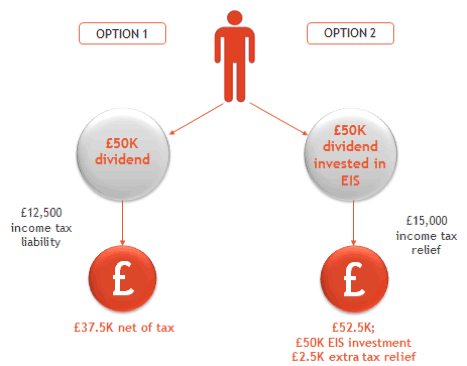

Many business owners are growing increasingly frustrated about the tax associated with extracting profit from their companies. Often referred to as ‘double taxation’, a company owner must first face corporation tax on profits made by their business and again when they decide to pay themselves a dividend or salary.
Enterprise Investment Schemes (EIS) can be used to extract profit from a business tax efficiently. EIS was introduced by the UK Government in 1994 in order to induce investment into UK smaller companies. In order to make investing in smaller companies more attractive, there are a number of tax reliefs available through EIS investments providing an investment is held for at least three years).
Income Tax relief
Capital Gains Tax (CGT) deferral
Inheritance Tax relief (IHT)
Mr Williams, a higher rate tax payer, owns a small business. He pays himself a £10,600 salary per year in order to stay within his personal allowance and no income tax is paid on this amount. In addition to this salary he pays himself a dividend each year which attracts an income tax liability. However, he is still frustrated with the amount of tax paid on the dividends.
 If Mr Williams pays himself £50,000 dividend, he will owe 25% (£12,500) in income tax on this (once we take the tax credits into account). This will leave him with £37,500 of net funds in his account after paying the tax.
If Mr Williams pays himself £50,000 dividend, he will owe 25% (£12,500) in income tax on this (once we take the tax credits into account). This will leave him with £37,500 of net funds in his account after paying the tax.
If Mr Williams invested the £50,000 into an EIS, he will be entitled to 30% income tax relief (£15,000). This tax rebate can be used to wipe out the £12,500 due on the dividend. It also leaves him with an extra £2,500 of income tax relief to set against other income tax he has paid across the current and/or previous tax year.
He is left with a £50,000 EIS investment, which he can liquidate once he has held the investment for three years. Providing the EIS investment has, at least, preserved its value Mr Williams has saved £15,000 in tax as a result of this investment.
Any growth within his EIS investment is tax free, as per the EIS rules.
Dividend tax rules will be changing in the new tax year, but this planning will very much still apply under the new legislation. However, for additional or higher rate tax payers the tax burden on dividends is likely to increase compared to the current tax year.
Whilst investing in smaller companies often involves higher levels of risk and worse levels of liquidity, many investment companies offer EIS investments that target capital preservation. These investments involve companies with long-term, index-linked and stable cash flows.
Not found your answer? Live chat is the quickest way to get in touch with a real person at Mariana or call us on 020 7065 6699
Start live chat »